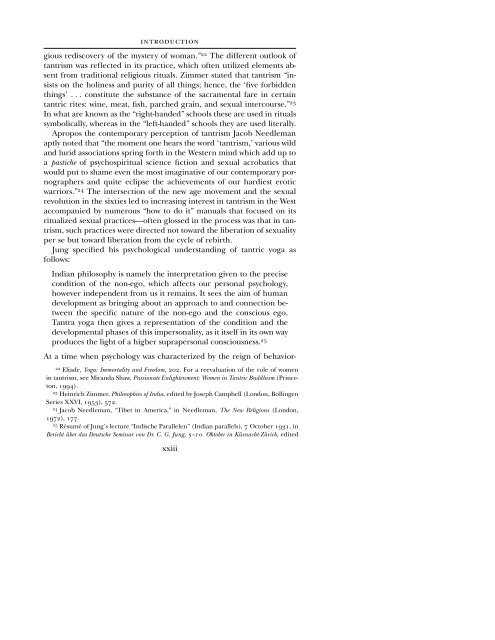CG JUNG - Countryside Anarchist
CG JUNG - Countryside Anarchist
CG JUNG - Countryside Anarchist
You also want an ePaper? Increase the reach of your titles
YUMPU automatically turns print PDFs into web optimized ePapers that Google loves.
INTRODUCTION<br />
gious rediscovery of the mystery of woman.” 22 The different outlook of<br />
tantrism was reflected in its practice, which often utilized elements absent<br />
from traditional religious rituals. Zimmer stated that tantrism “insists<br />
on the holiness and purity of all things; hence, the ‘five forbidden<br />
things’ . . . constitute the substance of the sacramental fare in certain<br />
tantric rites: wine, meat, fish, parched grain, and sexual intercourse.” 23<br />
In what are known as the “right-handed” schools these are used in rituals<br />
symbolically, whereas in the “left-handed” schools they are used literally.<br />
Apropos the contemporary perception of tantrism Jacob Needleman<br />
aptly noted that “the moment one hears the word ‘tantrism,’ various wild<br />
and lurid associations spring forth in the Western mind which add up to<br />
a pastiche of psychospiritual science fiction and sexual acrobatics that<br />
would put to shame even the most imaginative of our contemporary pornographers<br />
and quite eclipse the achievements of our hardiest erotic<br />
warriors.” 24 The intersection of the new age movement and the sexual<br />
revolution in the sixties led to increasing interest in tantrism in the West<br />
accompanied by numerous “how to do it” manuals that focused on its<br />
ritualized sexual practices—often glossed in the process was that in tantrism,<br />
such practices were directed not toward the liberation of sexuality<br />
per se but toward liberation from the cycle of rebirth.<br />
Jung specified his psychological understanding of tantric yoga as<br />
follows:<br />
Indian philosophy is namely the interpretation given to the precise<br />
condition of the non-ego, which affects our personal psychology,<br />
however independent from us it remains. It sees the aim of human<br />
development as bringing about an approach to and connection between<br />
the specific nature of the non-ego and the conscious ego.<br />
Tantra yoga then gives a representation of the condition and the<br />
developmental phases of this impersonality, as it itself in its own way<br />
produces the light of a higher suprapersonal consciousness. 25<br />
At a time when psychology was characterized by the reign of behavior-<br />
22 Eliade, Yoga: Immortality and Freedom, 202. For a reevaluation of the role of women<br />
in tantrism, see Miranda Shaw, Passionate Enlightenment: Women in Tantric Buddhism (Princeton,<br />
1994).<br />
23 Heinrich Zimmer, Philosophies of India, edited by Joseph Campbell (London, Bollingen<br />
Series XXVI, 1953), 572.<br />
24 Jacob Needleman, “Tibet in America,” in Needleman, The New Religions (London,<br />
1972), 177.<br />
25 Résumé of Jung’s lecture “Indische Parallelen” (Indian parallels), 7 October 1931, in<br />
Bericht über das Deutsche Seminar von Dr. C. G. Jung, 5–10. Oktober in Küsnacht-Zürich, edited<br />
xxiii


